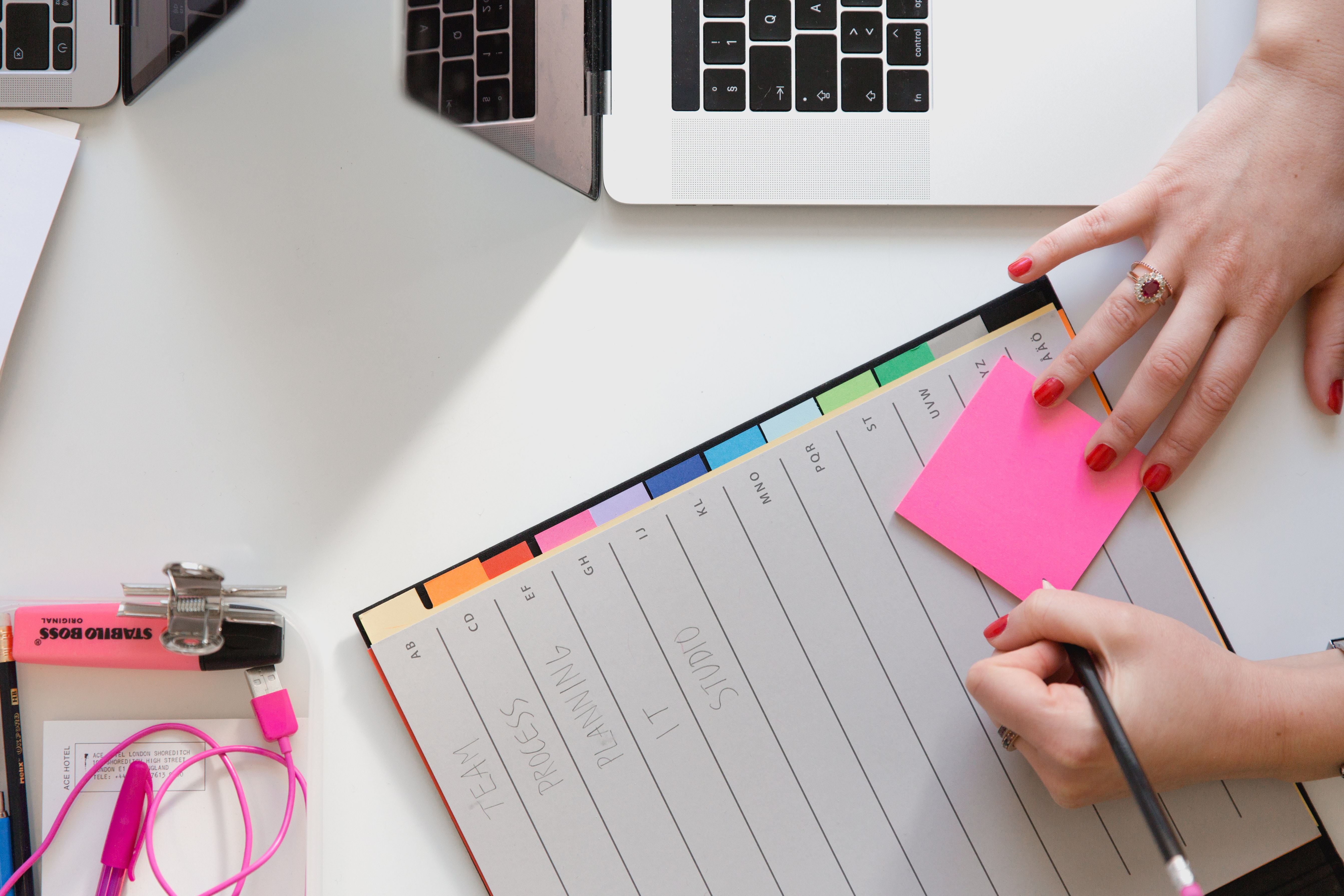In college, I was an Arabic major. I was also, hands down, the worst one in my Arabic class.
My first semester, I struggled even though I studied the same way my classmates did. I slogged through Arabic news broadcasts. I toiled over worksheets. I made online flashcards and charts and mnemonic devices. I even studied out loud with a partner. But nothing stuck.
One day, in the school store, I came across miniature index cards connected by a binder ring. And I thought, “Why not?” I’d already tried all the fancy flashcard apps that my professors swore by, but I decided to go back to good, old-fashioned pen and paper.
And the words stuck.
Once I discovered that I was a tactile reading/writing learner—someone who needs to both work with her hands and record information in writing—then everything flowed. The act of creating the cards and holding the words in my hands finally made vocabulary click.
If your target language just isn’t sticking, then maybe you should reevaluate the way you study. Figuring out your learning style can help you make the progress you never thought you could.
What are learning styles?

A learning style is the way that you best absorb information. When you utilize your learning style, information clicks faster and sticks better. Everyone’s style is a bit different. For example, some people have to draw pictures to remember information, while other people need to get physical.
Learning styles generally fit into four categories:
Kinesthetic learners are hands-on. They need to do, touch and experience in order to learn.
Auditory learners prefer to absorb new information by hearing it aloud.
Visual learners need to see something to understand it, and usually gravitate toward pictures.
Reading/writing learners lean toward words, and often understand a topic through copious notes.
How can you determine your learning style?

It takes a long time for some people to discover their learning style. Traditional schooling often preferences reading/writing learners; think about how many times you were expected to sit down, be quiet and take notes during class.
To figure out your style, you could take this quiz. Or this one. Or this. But if you’re used to abiding by traditional reading/writing schooling methods, and if you haven’t radically questioned the way you were taught to study, then quizzes might not offer the full profile.
So question your learning style. Experiment by trying out a few strategies from each category below.
After each activity you try, ask yourself:
- Did I find this fun?
- Was I engaged?
- How quickly did I retain the information, and for how long have I retained it?
- Would I do this again?
Take note of which category—or categories—your favorite activities fall into. You might be surprised!
Kinesthetic Learning

Kinesthetic learners need to be hands-on at all times. They don’t learn by sitting in a classroom. They learn by doing, by creating, by dismantling and rebuilding.
They often have a hard time sitting still in a traditional setting, because they’re itching to get their hands on something. They rarely read directions because they’re so eager to jump into tasks.
When learning a new language, kinesthetic learners often want to be on the streets, fully immersed in the language. They like being surrounded by the culture.
Ten study strategies for kinesthetic learners:
- When you study, immerse yourself in an environment related to your target language. If you can’t visit a country that speaks that language, then study at a local cultural center, or at least in a room where you can hang flags and play music. The environment is key.
- Review vocabulary flashcards while you’re doing something else, such as biking at the gym, walking to class or cooking.
- Walk back and forth when you’re studying boring information to keep yourself interested.
- Immerse yourself in a video game in your target language to learn while doing.
- Create hand motions or movements to remind you of tricky vocabulary and grammar constructions.
- Visit locations related to the information you’re studying, such as historical sites or museums.
- Roleplay, roleplay, roleplay. If you’re having trouble understanding a concept, put your boots on the ground and act it out.
- Create games, such as Jeopardy or a board game, to memorize difficult information. And use Scrabble to memorize vocabulary.
- Take 5-10 minute breaks frequently to help your brain refocus.
- When you have to read, such as when practicing reading comprehension, have paper, a pen and markers at hand so that you can keep your hands busy.
Auditory Learning

Auditory learners gravitate toward speech and sound. They learn best by hearing something spoken aloud, whether that’s through dialogue, lectures or music.
They might sit front row in a classroom, but don’t expect them to take notes; many auditory learners prefer to record lectures. (You might also find them subvocalizing at the library, muttering under their breath as they memorize information.) They often excel at oral reports and dominate class discussions.
When learning a new language, auditory learners want to speak. Always. To anyone. They love having conversations with their classmates or talking to native speakers, and they excel at memorizing music in their target language.
Ten study strategies for auditory learners:
- Record yourself reading your notes so that you can replay that recording while you’re doing other activities throughout your day.
- Without looking at your notes, explain difficult grammar concepts aloud as if you’re teaching them to someone.
- Listen to recordings of native speakers repeating vocabulary words.
- Memorize songs in your target language to help vocabulary and grammar concepts stick naturally.
- Speak! Link up with a native speaker and with language partners. Turn casual conversations into learning opportunities.
- Create songs and rhymes to remember vocabulary.
- Use the listening, recording and conversation feature on Rocket Languages to have full conversations with each lesson.
- Form a study group so that you and others can talk through difficult concepts.
- Record lectures.
- Listen to podcasts in your target language. Whenever you hear a word you don’t know, repeat it aloud, use context clues to figure out its meaning, and work it into your next conversation.
Visual Learning

Visual learners need to see information in order to retain it. Overall, they tend to be artists, people who are already oriented toward sight and color.
To study, some may draw simple pictures, while others create elaborate and color-coded diagrams, flow charts, lists and memory palaces. These are the kids in class who have twenty-four different colors of highlighters and a very specific system for each.
When learning a new language, visual learners love diagrams and flashcards. They also tend to enjoy TV shows and films in their target language, because the images give them something to focus on.
Ten study strategies for visual learners:
- Build a memory palace. This will let you literally walk through images to recall vocabulary.
- Grammar concepts got you stuck? Write out an example sentence in big letters on a sheet of paper. Then use highlighters and markers to break apart each section of the sentence, word by word, and diagram its grammatical function.
- Create vocabulary flashcards with images instead of English translations.
- Watch TV shows in your target language.
- Draw timelines and flowcharts.
- During a lecture, don’t just take notes. Doodle. Circle. Highlight. Underline. Turn your notes into a visual wonderscape.
- Hang vocabulary post-its and index cards around your house so that you see them during the day.
- Draw cartoons incorporating your vocabulary words.
- Turn information into charts, tables and maps.
- Hand-copy any diagrams or images from your textbooks into your own notes.
Reading/Writing Learning

Reading/writing learners love words. Words just make sense to them. To understand something, they need to see it in writing, or at least write it down (sometimes several times). They usually excel at traditional schooling, because traditional schooling is geared toward lectures and note-taking.
Their notes tend to be meticulous. If you open one of their books, you’ll find compulsive annotations. They consider their notebooks more precious than gold, and they probably have a preferred type of pen.
When learning a new language, reading/writing learners might be the only people in the world who don’t mind grammar. When learning new concepts, they need to see the concepts written out, and worksheets don’t terrify them. They also tend to enjoy textbooks.
Ten study strategies for reading/writing learners:
- On paper, explain difficult grammar concepts in your own words.
- If you’re really stuck, then write explanations of difficult concepts over and over again, explaining them slightly differently each time, until you fully understand them.
- Even if you take notes on a computer, print out the notes so that you can underline, highlight and review them whenever you have a free moment.
- On the flip side, if you have written notes, then take a photo so that you can review the notes on your phone when you’re on the go.
- To solidify grammar concepts, write stories in your target language.
- To solidify vocabulary words, write a short play or skit incorporating new terms.
- Write your notes in a question and answer format.
- Transfer your notes to post-its and index cards, and stick them all around your house so that you can see them throughout the day.
- Play word games with new vocabulary, such as hangman or Scrabble.
- Read books in your target language. If you prefer to watch TV shows, put the captions on.
Keep at it!
If you’re stuck now, don’t give up. You don’t need to study harder, you just need to study smarter, by figuring out your learning style.
So experiment, experiment, experiment. You might be surprised at what clicks!
Post by guest blogger Jamie McGhee: Jamie McGhee is a novelist, playwright and aspiring polyglot currently making her way through East Africa with a backpack.